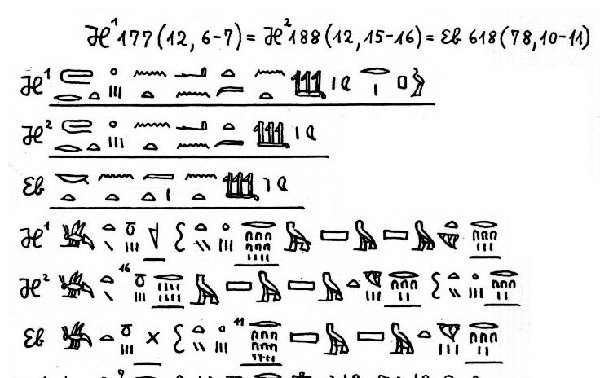|
EGYPT |
|---|
Prescriptions 177, 188

H = Hearst , Eb = Ebers papyrus:
Hearst Papyrus
Due to economic reasons (this museum just doesn’t have much $$ ), we were unable to obtain an actual print of the Hearst Medical Papyrus [located at U.C. Berkeley California]. However, the above page from the book “Die Mendizinischen Texte in Hieroglyphischer Umschreibung Autographiert” by Grapow Hermann, shows how similar formulas (H177, H188) contained within the Hearst papyrus are with the one (E618) found within the Ebers medical papyrus.
All three of these formulas dealt with sore feet in some form or another, and all three of them made use of Medical Cannabis. In fact it is interesting to note that Medical Cannabis found its way into foot remedies right up until the passage of the anti-Medical Marihuana laws in 1937.
The following is taken directly from our sister museum which deals with the origin of the anti-Medical Marihuana laws: [1]
Corn Removers / External Lotions:Cannabis was employed in the same papyrus as a poultice on a toenail (E 618, Ebers Papyrus 617- 618)
At the close of the 19th century, almost all corn removers, remedies and plasters, contained Cannabis as one of their key ingredients. It was used not only for its anti-bacterial properties, but also, at a time when [for psychological reasons] all good corn removers were expected to have a rich green color, served as an excellent (and inexpensive) coloring agent as well.
However, in 1937 (at the height of the great depression) the federal government placed a special $1 an ounce tax on all medical cannabis products. In the words of one newspaper article:"Corns Get 'Break' as Law Bars Sale Of Marijuana Cures Without License " . . . under a new federal law effective at midnight last night, druggists must be licensed to sell medicines containing marijuana ---and according to Thomas J. Ryen, secretary of the State Board of Pharmacy, most corn remedies contain this drug.And unfortunally, few of them did. Thus the era of Cannabis Corn Remedies was brought to an end.
All dealers must register with a collector of internal revenue," A.D. Stevenson, Narcotic Inspector in Columbus, said yesterday. . . .Meanwhile, Ralph White, past president of the Ohio State Pharmaceutical Association, said here that most retail druggists will not bother to get licenses . . . " --- The Youngstown Vindicator - Oct. 1, 1937
"If you find a painful finger or a toe, from water having been around them (serosity), their odor being malignant, whereas they have formed maggots [worms], you must say to this patient: “A problem that I can treat”. You must prepare for him treatments to kill the vermin [. . .]. Another for the toenail: honey: 1/4; ochre 1/64; cannabis: 1/32; hedjou resin: 1/32, ibou plant: 1/32. Prepare as for the preceding, and dress with it".[3]


FOOTNOTES:
[1] - www.ReeferMadnessMuseum.org
[2] - The Old Egyptian Medical Papyri by Chauncey D. Leake
[3] - 'Les papyrus me´dicaux de lAE´ gypte pharaonique : traduction inte´grale et commentaire',(p. 339) By T. Bardinet [translation E. B. R.] -- As taken from CHEMISTRY & BIODIVERSITY Vol.4 (2007) -- History of Cannabis and Its Preparations in Saga, Science, and Sobriquet by Ethan B. Russo
WANT TO KNOW MORE:
=====================
Due to space / download time considerations, only selected materials are displayed. If you would like to obtain more information, feel free to contact the museum. All our material is available (at cost) on CD-Rom format.
CONTACT PAGE
EGYPT Back to the Last Section |
 BACK TO MAIN SECTION |
EGYPT On to the Next Section |